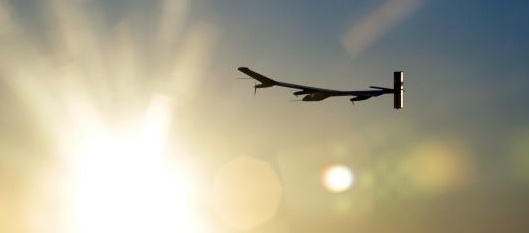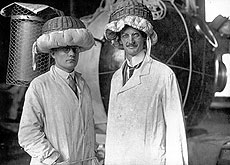Slow Aeronautics
By:
July 8, 2010

To the delight of its ground crew of engineers, media mavens, and soulful adventurers, Solar Impulse landed in Switzerland, this morning after a flight of 26 hours, 9 minutes — the longest ever for a solar-powered aircraft. With the wingspan of a jetliner, the bauplan of a dragonfly, and flying at a maximum speed of less than eighty miles an hour (and with an average speed of about 35 mph), Solar Impulse circled its home field in Payerne, reaching an altitude of more than 28,000 feet while drinking in solar rays and storing the energy in its batteries for a flight that would last through the night.
Piloted by Swiss air force veteran Andre Borschborg, Solar Impulse is promoted by Bertrand Piccard, the Swiss psychologist and aeronaut who copiloted the first hot air balloon to circumnavigate the globe. Piccard is the scion of a family of aeronauts and hydronauts — his grandfather Auguste Piccard (seen below with collaborator Paul Kipfer in fanciful headgear) pioneered the use of pressurized cabins in craft that floated both upwards to record altitudes and down to the oceans’ greatest depths.

Solar Impulse is not the first solar-powered aircraft. At the time of his death, Paul MacCready (1925-2007), who designed human-powered aircraft Gossamer Albatross and Gossamer Condor, was at work on an astonishing, jointed-wing solar craft, which he hoped would lead to airplanes that could fly indefinitely at great height, undulating through the upper reaches of the atmosphere at incredibly slow speeds to serve as airborne satellites.
It is said that technology developed in the Solar Impulse project may one day change commercial aviation. I’d like to imagine a transformation of society instead, in which spirited craft like those of MacCready and Piccard would seem practical and necessary. With slow food and slow media, maybe the time has come for a slow aeronautics?
